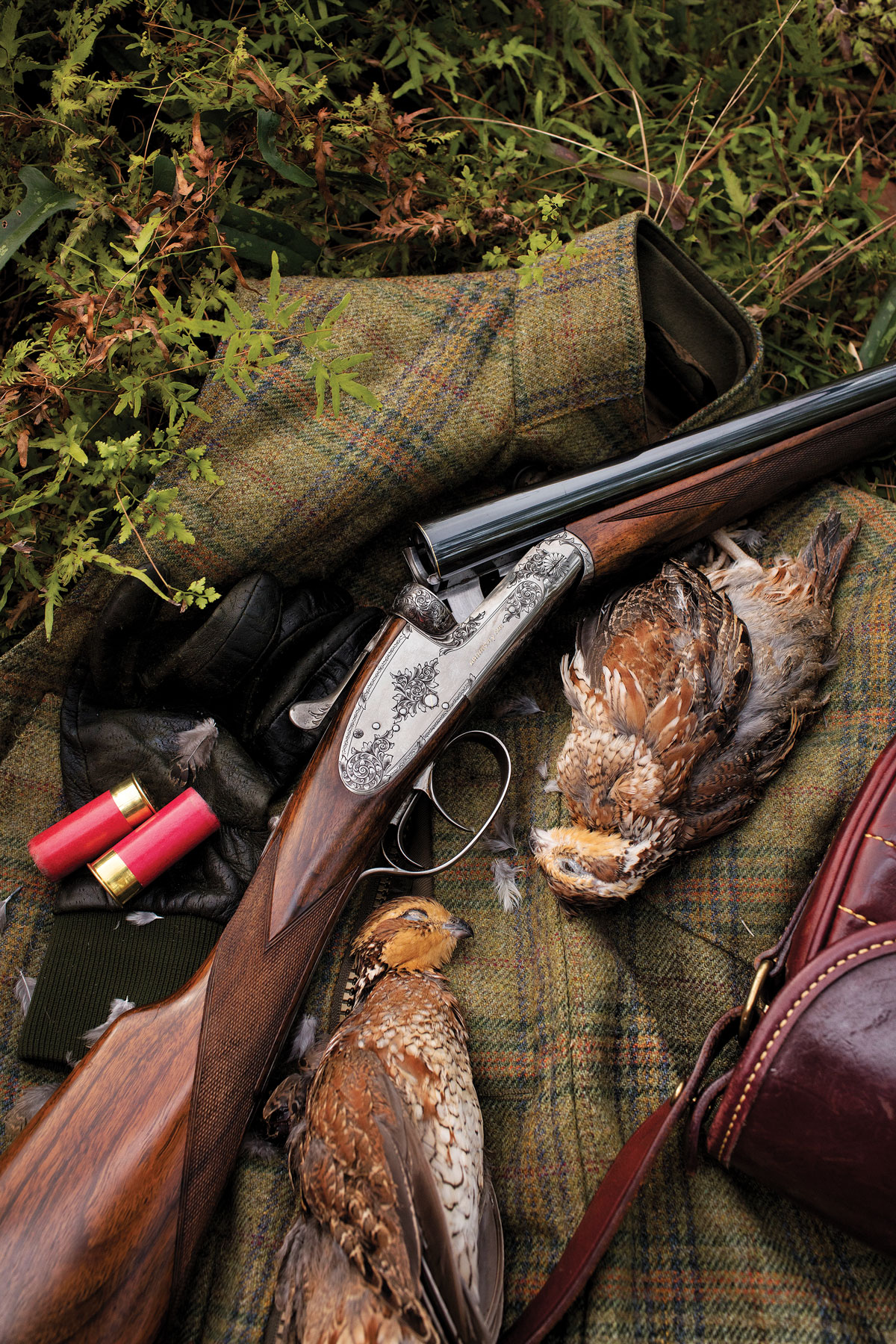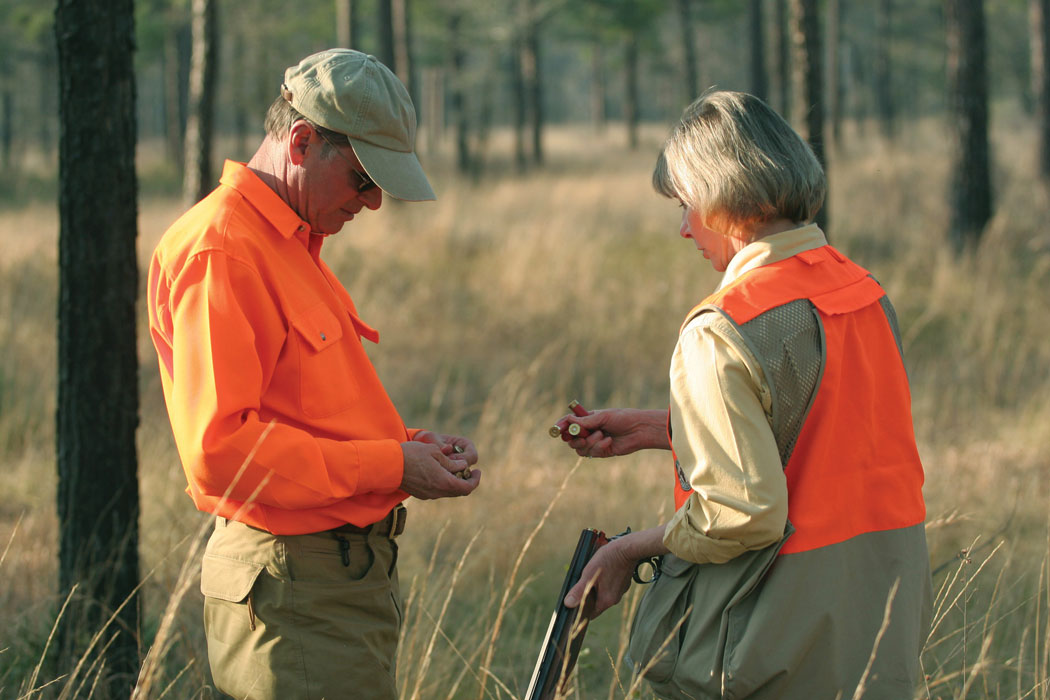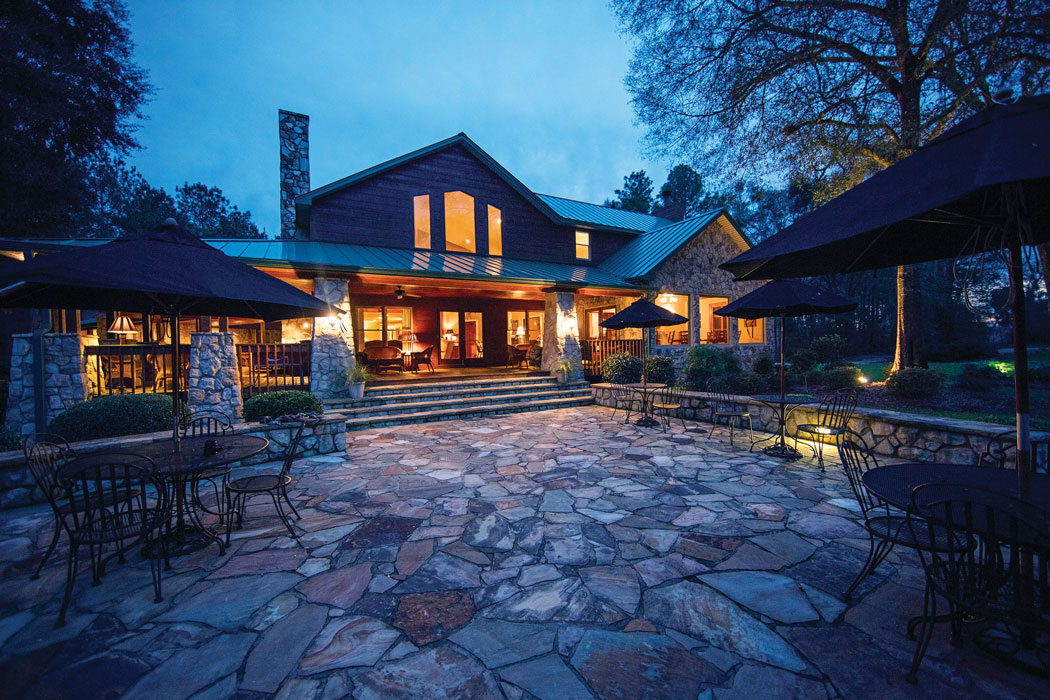
The return of Rio Piedra Plantation
By Vic Venters
Photographs by Terry Allen
In 1540 the army of Hernando de Soto clanked across a river that the Spanish conquistador dubbed Rio Piedra (“River of Rocks”) in what is now South Georgia at a place known as Sisters Islands. “We serve an al fresco lunch there for our guests on pretty days,” said 69-year-old Bill Atchison, owner of Rio Piedra Plantation, whose grounds encompass the fording site on the Flint River. “Can you imagine seeing de Soto crossing with 600 soldiers, 200 horses and 300 pigs?”
To his benefit, Atchison can; the romance of the Old South isn’t any more ancient than the mid-16th Century, and during the past decade and a half he and his wife, Annie, have harnessed the area’s beauty and mystique—and that of its signature gamebird—to rejuvenate an ailing quail plantation and transform it into a premier destination for wingshooters who pay $1,000 a day to hunt bobwhites in grand Southern style.

A quick look at lodge reviews on Orvis’s website shows more than 300 unsolicited five-star reviews from a legion of happy hunters who have visited. “Everyone loves Rio Piedra,” said SSM Contributing Editor Bruce Buck, who has hosted three of the magazine’s Readers & Writers Adventures there. “That shoot sells out almost every time.” Under the Atchisons’ ownership, Rio Piedra has won the Orvis Wingshooting Lodge of the Year award three times and is the only Orvis-endorsed lodge to have done so. According to Dan O’Connor, ex-Orvis employee and now general manager of North Carolina’s George Hi Plantation: “In the 10 years I ran the Orvis Endorsed Program I always thought Rio Piedra was the gold standard.”
Not bad for an owner who admits he “stumbled, tripped and sort of backed into” the high-end quail-plantation business in 2000. The year before, Atchison had been a Fortune 500 executive in Atlanta at The Coca-Cola Company’s corporate headquarters, where he was Vice President of Field Sales and Marketing. It was a grueling “seven-day-a-week” job and, although he was ready for a change from the company where he had worked for 32 years, Atchison was terrified by what he regarded as the “boredom of conventional retirement.”
Atchison had grown up rabbit hunting with his dad in northern Michigan and had taken to quail hunting in the early ’70s while living in San Antonio. But owning a sporting lodge wasn’t a lifelong dream or even a plan. The opportunity arose while Bill and Annie were entertaining Coca-Cola clients during a quail hunt in South Georgia. “We met a guy who was a guide and an assistant manager at an operation,” Bill said. “He wanted to be a manager, and he knew about some land that was for sale. We agreed to take a look.”
That look took the Atchisons to Camilla, in the northern tier of South Georgia’s plantation belt, where a small-but-high-quality lodge operated on the grounds of an old turpentine plantation whose name had once been Rio Piedra. It was a money suck for its owners—freighted with debt and hobbled by revenue that didn’t come close to covering expenses.
After a year of negotiations the couple purchased the operation—which included the lodge and about 2,000 acres of well-managed habitat. The initial idea was to run the business as absentee owners from Atlanta. “But that didn’t work,” said Bill, who quickly discovered that he and Annie were now part hoteliers, part restaurateurs and part recreational directors. Atchison took an early retirement package from Coke, and the couple moved south.
“We did not have a crystal-clear vision of what we would or should become,” recalled Atchison, who believes the initial business plan was muddled and unfocused. “We had not decided how we were going to differentiate ourselves in the market. We had not decided what we wanted our customer offering to look like. All we knew for sure was that we didn’t know much about our new business or the industry.”

The first priority for the new owners, however, was to staunch the bleeding. “The initial guest count was a trickle,” Atchison said, “about 10 to 15 percent of capacity at the time and not economically viable.”
The Atchisons renamed the place Rio Piedra Plantation after its historic moniker and embarked on a marketing campaign—hosting writers, advertising in upscale wingshooting magazines, building an attractive website, exhibiting at hunting shows, and developing relationships with travel agencies and, importantly, Orvis.
Marketing quickly doubled traffic, but Rio Piedra still was hemorrhaging cash. There also were missteps in the early efforts to build the business. A program to attract local corporate customers brought in day hunters but also sparked a clash of cultures. “The day hunters were mostly interested in numbers—‘How many did you get this morning?’” Atchison said. “The out-of-state visitors who were staying several days had come for the genteel Southern experience they had read about for years. The prospect of going to a killing mill did not appeal to them. Even casual conversation between the two groups was stilted.”
The Atchisons dropped the day-hunter program after a year, but that experience—and listening to their early clients—helped them discern what affluent bird hunters wanted and expected from a high-end Southern shooting lodge. That was a “total experience” built on refined-but-relaxed accommodations, fine dining, gracious Southern hospitality and, most paramount, what Atchison calls “real hunting,” which put a premium on free-ranging, hard-flying birds; good dogwork; and amiable, knowledgeable guides. “It took two or three years for that vision to become clear enough for us to execute against it,” Atchison said. “Once we got the customer offering locked down, the operating-level decisions got easier.”




Quail hunting is an old and hallowed tradition in Georgia, where the bobwhite is the official state gamebird. Nowadays it is also a troubled tradition: Since the early ’60s wild-quail populations have plunged more than 90 percent statewide, largely due to landscape-scale habitat degradation. The region’s private quail plantations, which comprise about 400,000 acres in a belt of properties that stretches from Albany south to Tallahassee, are important exceptions. There, thanks to intensive enlightened management, wild bobwhites are today more abundant than ever, with populations exceeding even those from the golden age at the turn of the 19th Century. Private plantations are also exceedingly private, with little access except to friends and family.
According to Georgia’s Department of Natural Resources, there are about 150 commercial operations in-state that have helped fill the void left by range-wide population declines—from blue-collar mom-and-pop preserves where quail are released literally minutes before they are shot to a handful of high-quality lodges like Rio Piedra that seek to replicate, as much as possible, the private-plantation experience.
The Atchisons also soon realized the importance of fine food and drink. “We set out to create the best restaurant between Atlanta and Tampa and offer meals that are unsurpassed in the industry,” Bill said. The couple hired (and have retained) Dirk Flachsmeier, a talented culinary-school-trained chef from Germany who steered the menu up and away from typical deep-fried hunting-lodge fare. “I happen to be a food person,” said John LeBlond, a retired attorney from Philadelphia who has hunted at Rio Piedra several times in the past decade. “And the food is top-notch. That’s important to me.”
The Atchisons gradually expanded the lodge to include private dining rooms, added five standalone cabins and constructed outdoor fireplaces for hunters to mingle around at the end of the day. The intent, Bill says, was not to gin up the head count but make “evening ambience” a focal point. “Our goal has been to create a Deep South plantation feel in a five-star setting.”
The quality of hunting has been aided partly by geography and partly by active management. Sited near private plantations in the area, Atchison says his bobwhite population benefits because wild birds do not recognize property boundaries. “Bobwhites move back and forth between private plantations and Rio Piedra for a number of reasons, ranging from food sources to predator movement to weather patterns,” he said. “So there is some variability in the number of coveys found each day. The birds here have to be hunted, not merely shot.”
No wild-bobwhite population in the Southeast can withstand pressure at commercial levels and still provide quality hunting, so Rio Piedra augments populations with summertime releases of eight-to-10-week-old reared birds, with periodic top-ups. Those quail that grow to maturity in the wild or survive even a couple of weeks soon present on the wing if not the pure explosiveness of a wild-bird flush, then a very creditable approximation of it.
Atchison and his land managers are redoubling efforts to improve habitat for wild quail.
Since the initial acquisition of the property, the Atchisons have tripled the size of Rio Piedra’s upland hunting areas with purchases of both contiguous and non-contiguous property on both banks of the Flint River. A ferry service across the scenic Flint links the two sides. Typically a guide in a Jeep Wrangler drives a pair of hunters into the uplands. “There are now 34 hunting areas,” Atchison said, “meaning a guest could stay for over two weeks and never walk the same ground. Our emphasis has been on creating an environment that is uncongested and as natural, real and tranquil as bird hunting was at the plantation 100 years ago.”
Amid wiregrass, towering pines and ancient live oaks draped with Spanish moss, quail are hunted on foot behind a brace or two of pointing dogs—often pointers but possibly setters, shorthairs or Brittanys from Rio Piedra’s kennel of more than 100 dogs. One of the most popular improvements has been adding flushing cocker spaniels (“toothy little ruffians,” according to Atchison). “We brought in cockers seven or eight years ago as a way to erase a couple of negatives,” Atchison explained. “One was safety. Walking out in front of the Guns to flush was potentially an occupational hazard to the guide. It could also be an annoyance to the Gun who was trying to shoot a bird and miss the guide. And we quickly learned cockers are a whole lot better at flushing than humans. Shooting instantly became more challenging.”
Adds John LeBlond: “For me, the cockers make the hunt!”
Two years after purchasing Rio Piedra, the Atchisons built a winter home on-site where they stay season long to oversee day-to-day operations and interact with the guests. “The owners stay on top of everything,” Bruce Buck said. “Every morning Annie will come in to check on her guests.”
Adds Reid Bryant, who today manages the Orvis Endorsed Lodge program: “When we see lodge owners who are present to the degree that Bill and Annie are, it almost goes without saying that it will be a great operation.”
Atchison says it took six years for Rio Piedra to show a profit. “It was a long slog getting to year six,” he said. “Then the recession hit. But we have been—we are not ashamed to say—increasingly profitable ever since.”
Atchison credits this to customers who return and spread the word about their experiences. “Our repeat business has grown to well over 90 percent,” he said. “And today new groups coming here are motivated mainly by what they have heard word of mouth. That makes us less reliant on the expensive marketing tactics we had to employ earlier.”
Though Rio Piedra is thriving nowadays, Atchison says he and Annie continue to polish its “premium brand offering,” to ensure it remains so. This year that includes expanding the kitchen, making room to add a pastry chef and a sous-chef. They also have added more dining areas for guests to spread out in. “It’s not about adding capacity or increasing guest count—we capped that years ago,” he said. “It’s about creating an open, spacious and relaxed atmosphere.
At its core, though, Rio Piedra is a hunting destination, and Atchison says he and his land managers are redoubling efforts to improve habitat specifically for wild quail. In addition to the annual prescribed burning and timber thinning that long has been a staple of quail management in the Southeast, this year Atchison has brought in heavy equipment and herbicides to remove hardwood brush that shades out both nesting cover and food-producing weeds and forbs—costly techniques mostly employed by those with deep pockets at private wild-bird plantations.
Atchison casts back his eyes for inspiration. “When de Soto passed through here 476 years ago,” he said, “he saw one huge longleaf-pine forest that stretched all the way out to Texas. Our habitat would look very familiar to him.”
And also to the gamebird that defines the South.
For more information, contact Rio Piedra Plantation, 229-336-1677.



